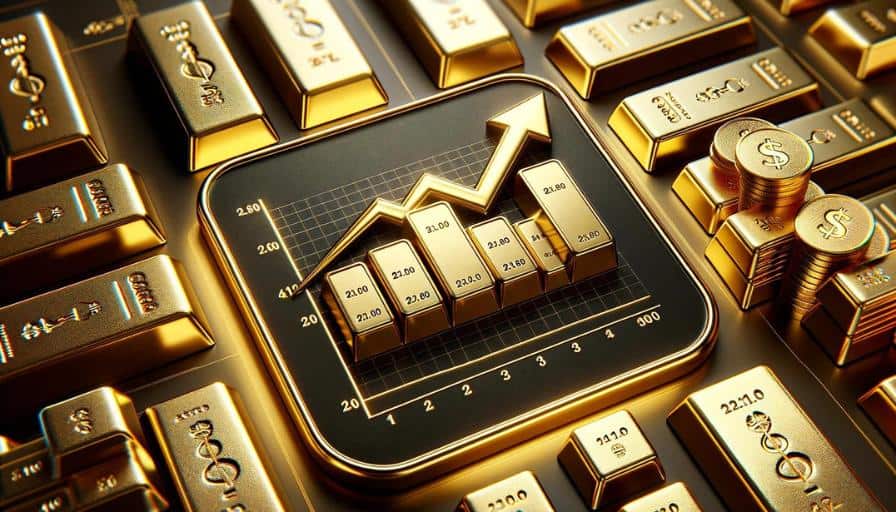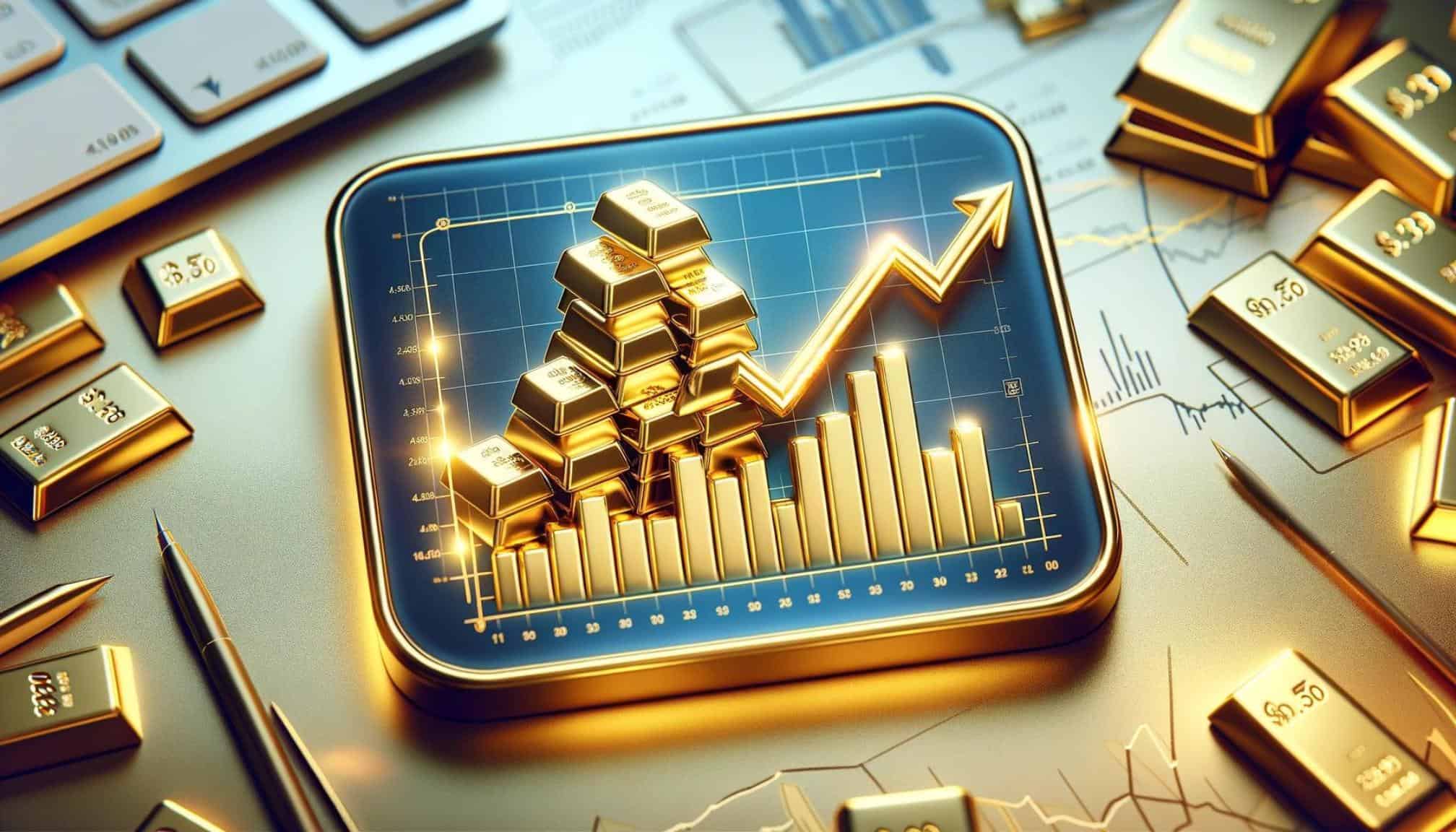Vangoldmining.com is a reader-supported site. We may earn a commission if you click links and make a purchase. This article is for informational purposes only, and does not constitute financial advice.
Gold, a symbol of wealth and stability, has been a cornerstone in the global economy for centuries. Its value, often seen as a reflection of economic health, has sparked significant interest, particularly concerning its future trajectory.
This article delves into the gold price predictions for the next 5 years, offering insights into what drives these forecasts and what investors might expect.
- Historical perspective: Gold has traditionally been a go-to asset during times of economic turbulence. Its price movements are closely watched by both individual and institutional investors.
- Current relevance: In today’s rapidly shifting economic landscape, characterized by concerns over inflation, geopolitical tensions, and market dynamics, understanding gold’s future price is more crucial than ever.
Expert Predictions for Gold Prices in the Next 5 Years
In this section, we analyze various expert predictions and financial forecasts to understand the potential trajectory of gold prices over the next five years.
- Fitch Solutions: Revised its expected gold price to average $1,950 per ounce in 2023, citing the March 2023 banking turmoil as a key factor.
- ANZ Research: Projected gold to be trading at around $2,100 by the end of 2023, influenced by US banking sector turbulence and elevated interest rates.
- World Bank: Expected gold prices to finish 2023 at $1,900, falling to $1,750 by the end of 2024.
- J.P. Morgan: Predicts gold prices might climb to new highs later in the year 2024, with a forecasted peak of $2,300/oz in 2025.
- Citigroup and Wells Fargo: Provided a range of predictions, with Citigroup anticipating prices up to $2,400 by the end of 2024, and Wells Fargo expecting between $2,100 – $2,200.
These varied predictions underscore the complexity of forecasting gold prices, influenced by multiple global economic and geopolitical factors.
Recent Trends in Gold Prices

Recent years have seen notable trends in the gold market, influenced by a range of factors:
- Past Price Movements:
- 2021-2023 Fluctuations: After a steady first half in 2021, gold prices saw an upward trend in the latter part, driven by inflation concerns and supply chain issues.
- 2022-2023 Rise: In 2022, gold prices peaked at $2,050 per ounce before experiencing a decline due to monetary policy tightening. However, by January 2023, prices had rebounded, surpassing $1,900.
- Impact of Global Events:
- Banking Crisis: The ongoing banking crisis, with financial institutions grappling with liquidity issues, has led investors to turn to gold as an alternative store of value.
- Geopolitical Tensions: High geopolitical tensions, such as the Israel–Hamas conflict and the Russia–Ukraine war, have bolstered gold’s appeal as a reliable store of value in uncertain times.
Factors Influencing Gold Prices
Several key factors are instrumental in shaping the future prices of gold. These include:
- Economic Factors:
- Inflation: Historically, gold has been a strong hedge against inflation. As living costs rise, the value of gold often increases, reflecting its purchasing power stability.
- Interest Rates: The relationship between gold and interest rates is inverse. Lower interest rates tend to make gold more attractive as they reduce the opportunity cost of holding non-yielding bullion.
- Recession Concerns: In times of economic downturn, gold prices typically rise as it is seen as a safer asset compared to volatile stock markets.
- Geopolitical Factors:
- Global Instability: Conflicts and political tensions can lead to increased demand for gold as a safe haven.
- Central Bank Policies: The decisions and policies of central banks, such as the Federal Reserve, play a significant role in gold pricing. For instance, the Fed’s rate hikes and monetary policy directly impact gold’s value.
Technical Analysis of Gold Prices
Technical analysis offers another lens through which to view future gold price movements. This section employs technical indicators to assess potential trends.
- Trend Indicators:
- Moving Averages: Analyzing long-term and short-term moving averages to identify bullish or bearish trends in gold prices.
- RSI (Relative Strength Index): Evaluating overbought or oversold conditions in the gold market.
- MACD (Moving Average Convergence Divergence): Detecting changes in momentum, which could indicate potential price reversals or continuations.
- Bollinger Bands: Understanding volatility and potential price targets.
- Support and Resistance Levels: Identifying key price points where gold prices might experience buying or selling pressure.
Global Economic Outlook and Its Impact on Gold
The global economic outlook plays a significant role in determining the direction of gold prices. This section explores how broader economic trends might influence gold markets.
- US Dollar Strength: As the US dollar and gold prices are typically inversely correlated, fluctuations in the dollar’s value can significantly impact gold prices.
- Economic Uncertainty and Recessions: During times of economic uncertainty or recession, gold often becomes a preferred investment, acting as a hedge against market volatility.
- Interest Rate Trends: The direction of interest rates, particularly those set by the Federal Reserve, can influence gold prices. Lower interest rates generally make gold more attractive as they reduce the opportunity cost of holding non-yielding assets like gold.
- Global Trade and Central Bank Policies: The state of global trade and central bank policies, especially in major economies, can have far-reaching effects on gold prices. For example, central bank buying or selling of gold reserves can significantly impact the market.
These factors collectively paint a picture of a complex and interwoven set of influences on gold prices, necessitating a multifaceted approach to understanding and predicting future trends.
Potential Risks and Opportunities in Gold Investment
Investing in gold presents a blend of risks and opportunities. Understanding these aspects is crucial for any investor considering gold as part of their portfolio.
Risks in Gold Investment:
- Market Volatility: Like any other asset, gold prices are subject to market fluctuations, which can be influenced by global economic conditions, geopolitical events, and currency fluctuations.
- Opportunity Cost: Holding gold, which typically does not yield interest or dividends, might result in a loss of potential income from other investments.
- Liquidity Concerns: While gold is often considered a liquid asset, the ease of converting it to cash can vary based on market conditions and the form of gold held (e.g., physical gold vs. gold ETFs).
Opportunities in Gold Investment:
- Inflation Hedge: Gold is often seen as a hedge against inflation, maintaining its value as the purchasing power of fiat currencies decreases.
- Diversification: Gold can diversify a portfolio, potentially reducing risk as its price movement often differs from stocks and bonds.
- Safe Haven Asset: During times of economic uncertainty or geopolitical tensions, gold is traditionally viewed as a safe haven, attracting investors looking for stability.
FAQs on Gold Price Predictions
Addressing common questions can provide clarity on gold price predictions. Here are some frequently asked questions:
- What factors are likely to influence gold prices the most in the next 5 years?
- Global economic uncertainty, inflation rates, interest rate trends, geopolitical tensions, and central bank policies are key factors.
- How reliable are gold price forecasts?
- While forecasts provide a general direction, they are not infallible due to the unpredictability of market and geopolitical factors.
- Can gold maintain its value in a digital economy?
- Gold’s historical status as a store of value suggests it can maintain relevance, even in a digital economy, through instruments like digital gold tokens and gold-backed ETFs.
- Is investing in gold a good strategy during economic downturns?
- Gold is often considered a safe haven during economic downturns, but investors should consider their individual financial situations and risk tolerance.
Conclusion: The Future of Gold Prices
In conclusion, predicting gold prices for the next 5 years involves considering a multitude of factors, including economic trends, market dynamics, geopolitical events, and technical indicators. The varying expert predictions and analyses underscore the complexity and uncertainties involved. Investors should approach gold investment with a balanced understanding of its risks and opportunities, keeping in mind that gold’s role as a hedge against inflation and a safe haven asset remains a constant in an ever-evolving economic landscape.



